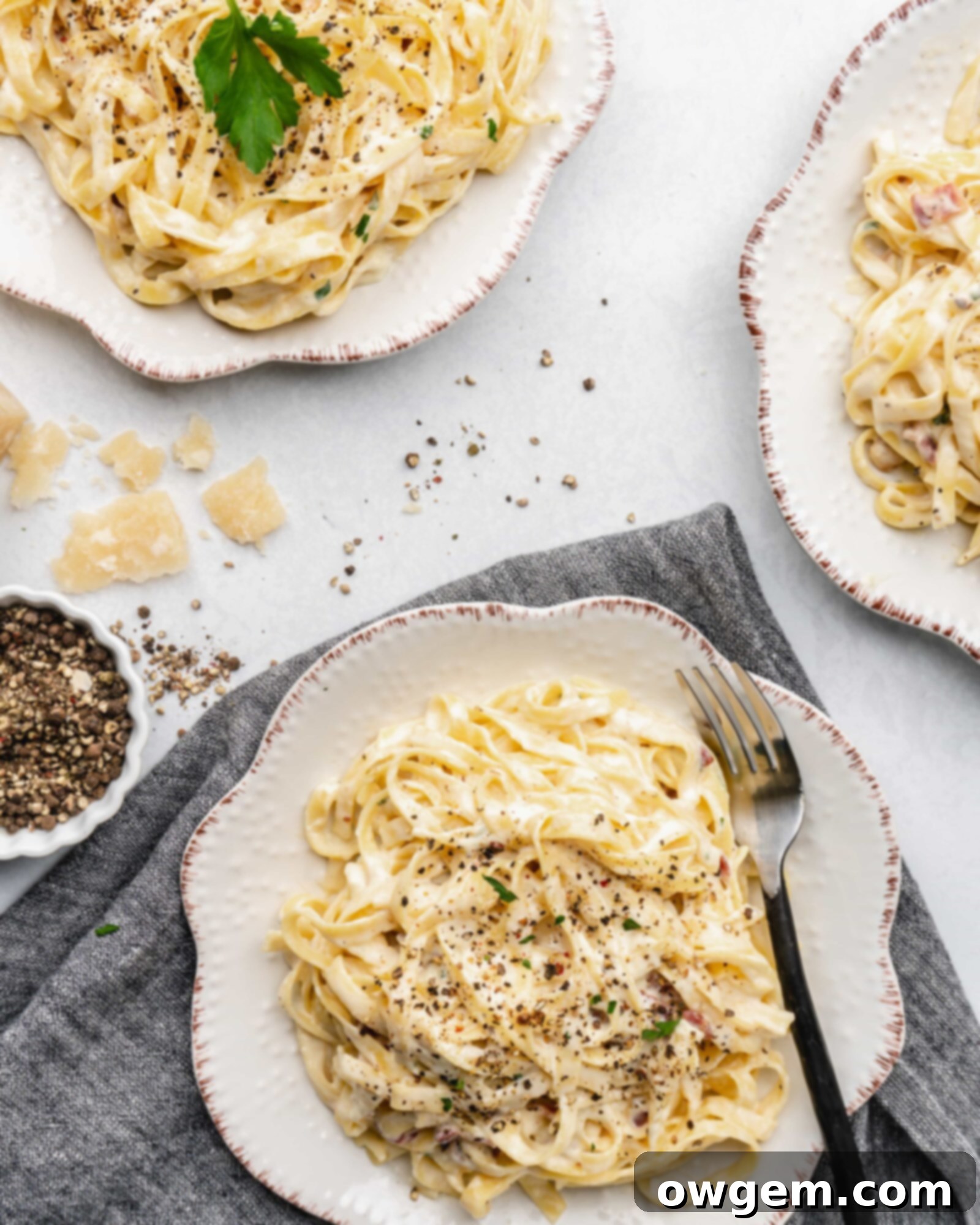Mastering Authentic Creamy Pasta Carbonara: Your Ultimate Guide to an Easy Homemade Italian Classic
Unlock the secrets to crafting a perfect, easy Pasta Carbonara with this comprehensive how-to guide and recipe. This once seemingly daunting Italian classic will become your new favorite dish to prepare, thanks to straightforward instructions and invaluable tips and tricks. Prepare to impress yourself and your loved ones as you transform into a carbonara master in no time!
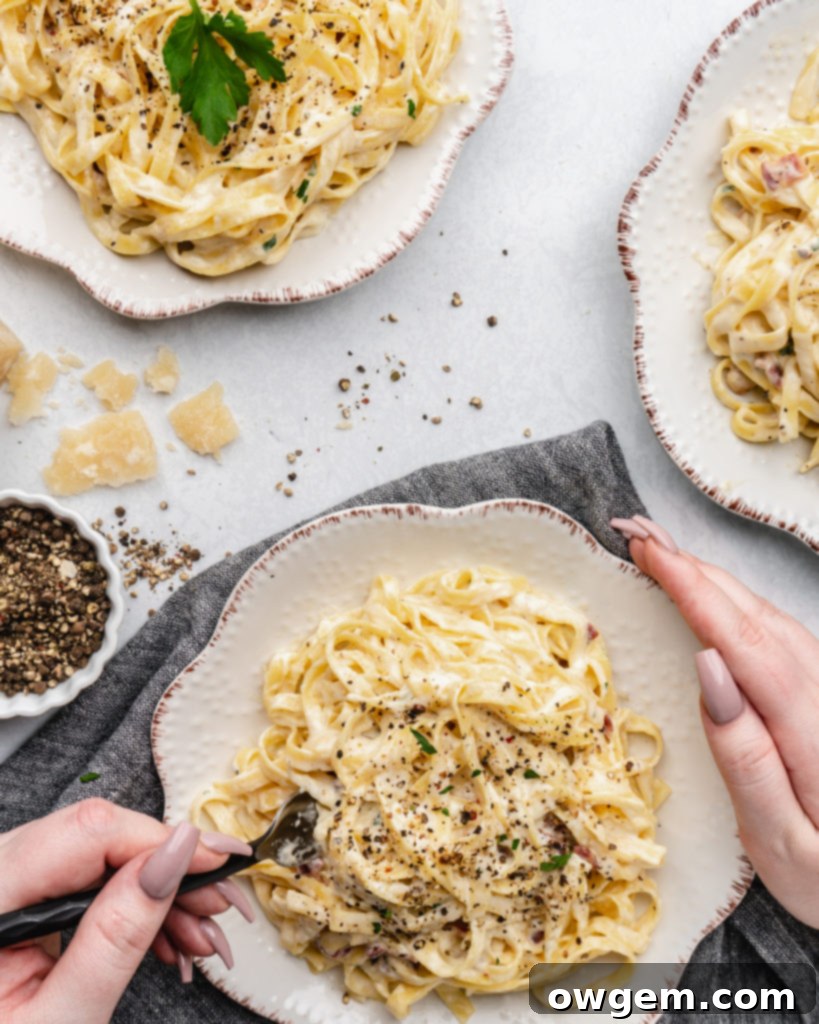
From Scrambled Eggs to Silky Perfection: My Carbonara Journey
For many years, my relationship with pasta carbonara was a complex blend of curiosity and outright fear. My inaugural encounter with this iconic dish happened at an Italian restaurant during a family vacation. The description – pasta, eggs, Italian bacon, and Parmesan – promised a harmonious symphony of flavors. What I received, however, was a culinary disaster: scrambled eggs haphazardly mixed with overcooked pasta and bacon. It was utterly horrendous. New to the dish, and unsure if this was some regional variation, I was too intimidated to send it back. I sat there, discreetly attempting to salvage something edible from the mess, wondering how a reputable establishment could serve such an abomination.
That initial experience understandably created a significant distance between me and any dish bearing the name “carbonara.” The memory of those rubbery eggs lingered, solidifying my apprehension. It wasn’t until several years later, dining out with a friend, that my perspective completely shifted. She ordered carbonara, and what arrived at our table was a masterpiece: a plate of beautifully glistening pasta, coated in a rich, creamy sauce, adorned with crispy bits of Italian cured pork. “That can’t be pasta carbonara,” I silently questioned, my mind still scarred by past trauma. A quick search on my phone, however, revealed the truth: my friend’s dish was the authentic, delectable carbonara I had always imagined, and the version I had been served years prior was, in fact, carbonara gone horribly, terribly wrong.
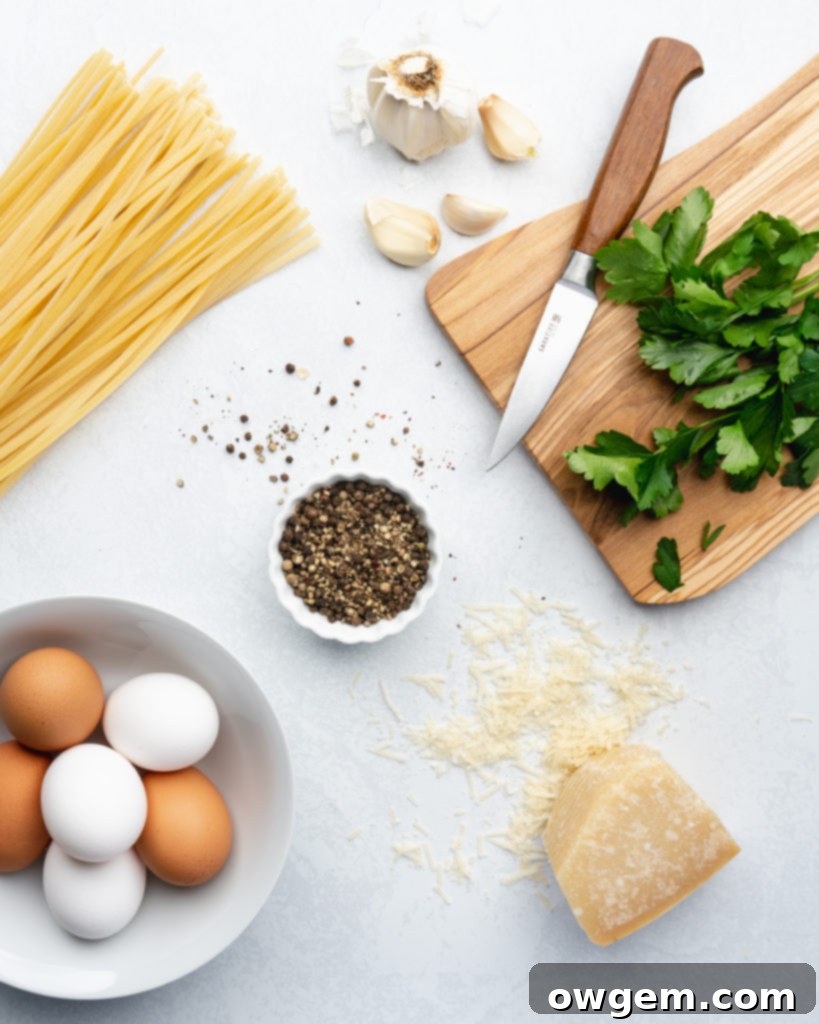
My First Foray into Homemade Carbonara: Conquering the Fear
Inspired and determined to right past wrongs, I embarked on my personal quest to create the perfect pasta carbonara. I immersed myself in Food Network videos, devouring countless recipes and instructions, memorizing every detail to avoid repeating my previous scrambled-egg nightmare. The moment came to add the egg yolks to the pasta, and my anxiety levels were through the roof. With bated breath, I poured in the yolks, vigorously tossing the pasta, biting my lip in anticipation. The result? Pure, unadulterated perfection. A silky, creamy sauce clung to every strand of pasta, creating a dish that was both comforting and elegant.
My initial stress and fear surrounding this dish were, as it turned out, entirely unwarranted. While it’s true that scrambling the eggs is a common pitfall, avoiding it doesn’t require Michelin-star chef skills. It simply demands adherence to the recipe steps and, crucially, patience. The key lies in incorporating the hot pasta into the rendered pancetta fat, tossing it thoroughly to cool the mixture just enough before introducing the egg yolks. This careful temperature modulation prevents the eggs from overcooking and scrambling. Patience is paramount throughout the process; resist the urge to rush any step or crank up the heat excessively while attempting to thicken the sauce. With these fundamental principles in mind, anyone can achieve carbonara mastery and create a truly delicious, restaurant-quality dish right in their own kitchen.
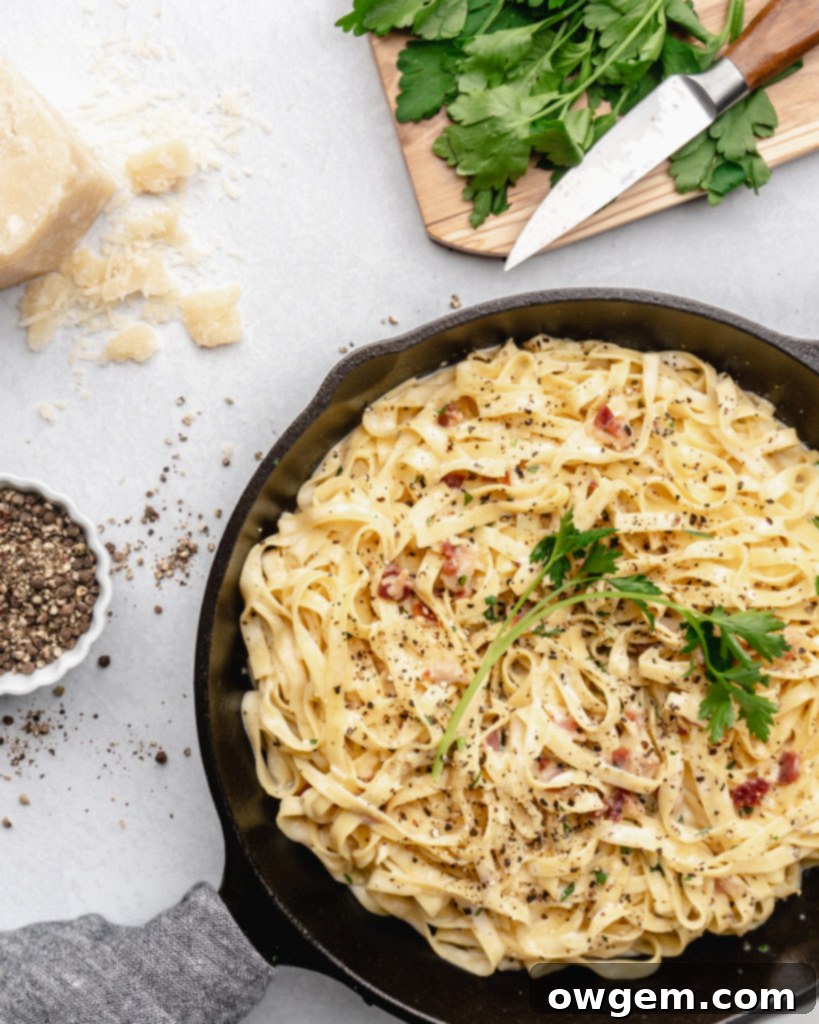
To ensure your journey to perfect, easy pasta carbonara is smooth and successful, I’ve compiled a list of essential tips, tricks, and variations. These insights will not only help you avoid common mistakes but also empower you to customize the dish to your liking.
Essential Tips, Tricks, and Must-Do’s for Perfect Carbonara
1. Synchronized Cooking: Pasta and Sauce. It is absolutely crucial that your pasta finishes cooking at approximately the same time you’re preparing your pancetta and butter/oil base. The magic of carbonara relies on the heat of the freshly cooked pasta to gently cook and emulsify the egg mixture into a rich, velvety sauce. If the pasta isn’t hot enough, the eggs won’t thicken properly, leading to a runny or clumpy sauce. Conversely, ensure the pan with the pancetta isn’t scalding hot when the pasta is added. Tossing the hot pasta directly into the hot fat helps distribute heat evenly and slightly cools the pan, reducing the risk of scrambling the eggs upon egg mixture addition. Should your sauce turn out a little too loose after combining everything, you *can* carefully warm the dish over very low-medium heat, stirring constantly, until it reaches the desired consistency. Just remember, slow and steady wins the race when it comes to heat and eggs.
2. Patience is a Virtue. As emphasized earlier, succumbing to impatience and trying to rush the process by using excessively high heat is the quickest way to ruin your carbonara. The delicate balance of heat and constant stirring is what creates that signature creamy texture. High heat will instantly curdle or scramble the eggs, transforming your beautiful sauce into an unfortunate breakfast scramble. Trust the process, maintain a moderate temperature, and allow the ingredients to coalesce gradually.
3. Salt Strategically. Many cooks instinctively reach for the salt shaker early in the cooking process, but with carbonara, restraint is key. Pancetta, the Italian cured pork belly, is naturally quite salty. Furthermore, this recipe calls for Pecorino Romano cheese, which is notably saltier and sharper than Parmigiano Reggiano. Adding salt prematurely can result in an overly salty dish that’s difficult to correct. Instead, wait until all components are combined and the sauce is finalized. Taste the carbonara first, then season with freshly ground black pepper, and only add additional salt if absolutely necessary.
4. Invest in Quality Ingredients. Carbonara is a dish celebrated for its simplicity, relying on just a handful of core ingredients. This means there’s no hiding place for subpar components. The quality of each element shines through, making a significant impact on the final flavor and texture. While good quality dried pasta is important, the biggest difference will be noticed in your cheeses, pancetta (or guanciale), and egg yolks. Seek out fresh, vibrant egg yolks, authentic Pecorino Romano and Parmigiano Reggiano, and high-quality pancetta. These investments will elevate your carbonara from good to truly exceptional.
5. Opt for Long Pasta Varieties. Traditional carbonara is almost always made with long pasta, such as spaghetti, bucatini, or rigatoni. These shapes are ideal because their elongated strands offer ample surface area for the rich, eggy sauce to cling to, creating that perfect coating in every bite. While you *can* use shorter pasta, they tend to expose more of the hot pan’s surface during tossing, increasing the risk of the eggs scrambling. If you do choose a shorter variety, a helpful trick is to toss the pasta with the rendered fat and pancetta in the pan, then immediately transfer it to a separate, warmed bowl to mix in the egg and cream mixture. This extra step helps prevent scrambling.
6. Bring Yolks and Heavy Cream to Room Temperature. For optimal results, ensure your egg yolks and heavy cream are at room temperature before mixing them together. Cold ingredients can shock the system, so to speak, when introduced to hot pasta, making it harder for them to emulsify evenly and increasing the chance of an inconsistent sauce. Room temperature ingredients blend more smoothly and warm up more gently with the pasta’s residual heat, leading to a consistently creamy and homogenous sauce, free from lumps or curdled bits.
7. The Cream Debate: A Modern Approach. While purists argue that authentic Roman carbonara contains no cream, relying solely on egg yolks, Pecorino Romano, and pasta water for its creaminess, I’ve experimented with countless variations – just yolks, whole eggs, and various amounts of cream. I’ve found that for a consistently rich, creamy, and forgiving sauce that appeals to most palates, including my family and friends, a combination of egg yolks and a touch of heavy cream yields the best results. The cream not only enhances the luxurious texture but also acts as a helpful buffer, significantly reducing the likelihood of scrambling the eggs for home cooks. Embrace this addition for a more confident and delicious carbonara experience.
Creative Variations to Make Carbonara Your Own
8. Pancetta vs. Bacon: Understanding the Flavor Profile. If pancetta is unavailable, you *can* substitute it with good quality smoked bacon. However, be aware that this will fundamentally alter the flavor of your carbonara. Pancetta is cured and unsmoked, offering a delicate, savory richness that harmonizes beautifully with the other ingredients without overpowering them. Bacon, on the other hand, is cured and smoked, imparting a much stronger, more dominant smoky flavor to the dish. If you enjoy a robust smoky note and are in a pinch, bacon can work. But for a taste that is closer to the authentic Italian experience, pancetta is the preferred choice, allowing the subtle nuances of the cheese and eggs to shine.
9. Personalizing Your Carbonara: Additions and Enhancements. While traditional carbonara relies on its core ingredients, feel free to add a few complementary ingredients if they suit your taste. Some cooks enjoy sautéing finely diced onions or minced garlic with the pancetta to build a deeper aromatic base. Others might add fresh or frozen peas to the dish for a pop of color and sweetness, or even cooked chicken for an added protein boost, transforming it into a “chicken carbonara.” A personal favorite, though not traditional, is to finish the dish with a delicate sprinkle of fresh lemon zest. This unexpected addition provides a bright, refreshing counterpoint to the richness of the carbonara, lifting the flavors and adding a delightful tang. Don’t be afraid to experiment and make this classic truly your own!
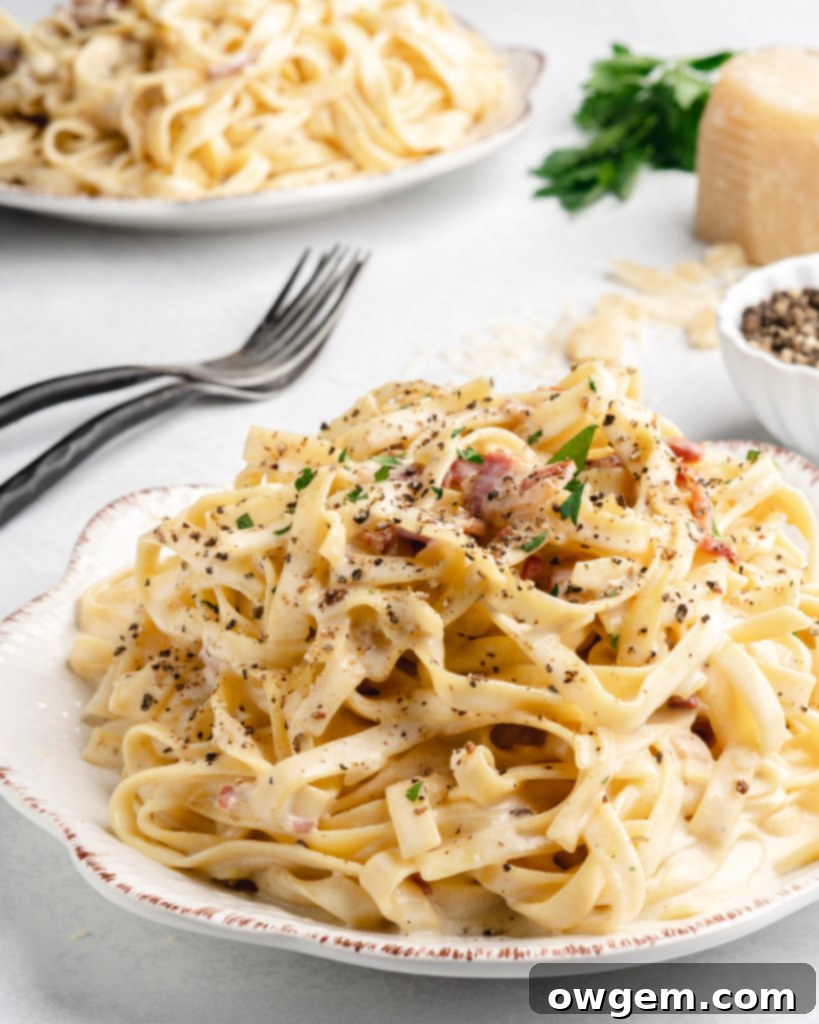

Get the Recipe:
Pasta Carbonara
Pin
Rate
Ingredients
- 340 grams (12 oz) Long Variety Pasta,, such as Spaghetti
- 1 cup Reserved Pasta Water
- 1/2 tbsp Butter
- 1/2 tbsp Olive Oil
- 120 grams Pancetta,, cut into small cubes
- 2 Garlic Cloves,, crushed or minced
- 1-2 tbsp Fresh Parsley, , finely chopped
- 6 Egg Yolks
- 1/2 cup Heavy Cream,, room temperature
- 60 grams Pecorino Romano,, finely grated
- 60 grams Parmigiano Reggiano,, finely grated
- Salt & Pepper,, to taste
- Lemon Zest,, to finish (optional)
Instructions
-
Bring a large pot of well-salted water to a rolling boil and add your chosen pasta. Cook according to the package directions, which is typically around 8-10 minutes for al dente. Before draining, remember to reserve 1 cup of the starchy pasta water – this is crucial for the sauce!
-
While the pasta cooks, prepare your sauce base. In a small bowl, whisk together the heavy cream, egg yolks, and fresh parsley until thoroughly smooth and well combined. Set aside. Next, in a large, deep skillet or pan, melt the butter with the olive oil over medium heat. Add the cubed pancetta to the pan and cook, stirring occasionally, until it renders its fat and turns golden brown and crispy. Then, add the crushed or minced garlic to the pan and continue to sauté for an additional 1-2 minutes. The garlic should be fragrant but not browned or burnt, and the pancetta should be beautifully golden brown, similar to perfectly cooked bacon.
-
Immediately remove the pan from the heat. Drain the cooked pasta (remembering your reserved pasta water!) and add it directly to the pan with the pancetta and rendered fat. Toss vigorously until the pasta is evenly coated. Then, pour the cream and egg mixture over the pasta in the pan and continue to quickly and thoroughly toss everything together. The residual heat from the hot pasta is what gently cooks and thickens the egg mixture into a luscious, creamy sauce. Keep tossing until it starts to emulsify.
-
Add both the finely grated Pecorino Romano and Parmigiano Reggiano cheeses to the pasta and toss to combine, allowing the cheese to melt into the sauce. Gradually add the reserved pasta water, a small increment at a time (1-2 tablespoons), continuously tossing and stirring. Continue this process until the sauce achieves a creamy, glossy, and silky consistency – it should be loose enough to easily coat and pull through the pasta, but not watery.
-
Optional: If, after continuous tossing and adding pasta water, the pasta and sauce are still too loose in consistency, you may return the pan to the stove and continue cooking over very low heat. Stir constantly until the sauce thickens to your liking. Exercise extreme caution not to heat too quickly or overheat, as this will inevitably scramble the eggs. This step requires patience and vigilance.
-
Finally, season your carbonara with freshly ground salt and pepper to taste. Remember to taste before adding salt, given the inherent saltiness of the pancetta and cheeses. Serve immediately, garnished with a sprinkle of extra Parmesan and fresh parsley. For an optional bright finish, grate a small amount of lemon zest over each serving to add an unexpected zing that beautifully cuts through the richness. Enjoy your perfectly homemade Pasta Carbonara!
